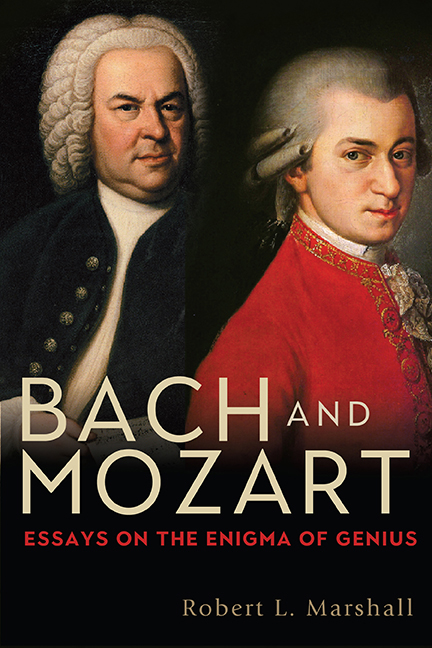Book contents
- Frontmatter
- Dedication
- Epigraph
- Contents
- List of Figures
- Preface
- List of Abbreviations
- Prologue. The Century of Bach and Mozart as a Music-Historical Epoch: A Different Argument for the Proposition
- 1 Young Man Bach: Toward a Twenty-First-Century Bach Biography
- 2 The Notebooks for Wilhelm Friedemann and Anna Magdalena Bach: Some Biographical Lessons
- 3 Bach and Luther
- 4 Redeeming the St. John Passion–and J. S. Bach
- 5 Bach's Keyboard Music
- 6 The Minimalist and Traditionalist Approaches to Performing Bach's Choral Music: Some Further Thoughts
- 7 Truth and Beauty: J. S. Bach at the Crossroads of Cultural History
- 8 Bach at Mid-Life: The Christmas Oratorio and the Search for New Paths
- 9 Bach at the Boundaries of Music History: Preliminary Reflections on the B-Minor Mass and the Late-Style Paradigm
- 10 Father and Sons: Confronting a Uniquely Daunting Paternal Legacy
- 11 Johann Christian Bach and Eros
- 12 Bach and Mozart: Styles of Musical Genius
- 13 Mozart and Amadeus
- 14 Bach and Mozart's Artistic Maturity
- 15 Mozart's Unfinished: Some Lessons of the Fragments
- Epilogue (ossia Postmortem). Had Mozart Lived Longer: Some Cautious (and Incautious) Speculations
- Notes
- Works Cited
- Index
- Miscellaneous Endmatter
- Eastman Studies in Music
3 - Bach and Luther
Published online by Cambridge University Press: 29 March 2020
- Frontmatter
- Dedication
- Epigraph
- Contents
- List of Figures
- Preface
- List of Abbreviations
- Prologue. The Century of Bach and Mozart as a Music-Historical Epoch: A Different Argument for the Proposition
- 1 Young Man Bach: Toward a Twenty-First-Century Bach Biography
- 2 The Notebooks for Wilhelm Friedemann and Anna Magdalena Bach: Some Biographical Lessons
- 3 Bach and Luther
- 4 Redeeming the St. John Passion–and J. S. Bach
- 5 Bach's Keyboard Music
- 6 The Minimalist and Traditionalist Approaches to Performing Bach's Choral Music: Some Further Thoughts
- 7 Truth and Beauty: J. S. Bach at the Crossroads of Cultural History
- 8 Bach at Mid-Life: The Christmas Oratorio and the Search for New Paths
- 9 Bach at the Boundaries of Music History: Preliminary Reflections on the B-Minor Mass and the Late-Style Paradigm
- 10 Father and Sons: Confronting a Uniquely Daunting Paternal Legacy
- 11 Johann Christian Bach and Eros
- 12 Bach and Mozart: Styles of Musical Genius
- 13 Mozart and Amadeus
- 14 Bach and Mozart's Artistic Maturity
- 15 Mozart's Unfinished: Some Lessons of the Fragments
- Epilogue (ossia Postmortem). Had Mozart Lived Longer: Some Cautious (and Incautious) Speculations
- Notes
- Works Cited
- Index
- Miscellaneous Endmatter
- Eastman Studies in Music
Summary
In the year 1708, that is, at the age of twenty-three, young Johann Sebastian Bach resigned his respected post as organist of the Blasiuskirche in the imperial free city of Mühlhausen. He announced, among other things—as we have seen—that his “ulti-mate goal” was to perform what he described as “a well-regulated church music” (ich stets den Endzweck, nemlich eine regulirte kirchen music … gerne aufführen mögen). But it is not altogether clear exactly what the composer had in mind. The transla-tion in NBR (p. 57) reads: “I should always have liked to work toward the goal, namely, a well-regulated church music to the Glory of God.” It thus avoids trans-lating the operative German verb “aufführen.” Usually rendered in English as “to perform,” it also can mean “to present” or “produce.” One would like to think that for the formidably gifted Johann Sebastian Bach it also implied “to create”—that is, to compose, and not just to perform. Regarding the term “regulirt”: Ulrich Siegele argues that by “regular church music” (regulirte kirchen music), Bach was not think-ing of regular—that is, weekly (or monthly)—performances of church cantatas (as easily assumed), but rather of performances delivered by “regular,” essentially profes-sional, musicians—hence his use of a term commonly associated with a “regular” (i.e., professional) army. Bach's letter continues, “and therefore [I] have acquired … not without cost, a good store of the choicest church compositions” (und darümb … nicht sonder kosten, einen guthen apparat der auserleßensten kirchen Stücken mir angeschaffet). The reference to having “therefore” (darümb) “purchased” (“acquired”) (angeschaffet) “the choicest church compositions” (no doubt works composed by others) strongly suggests that his Endzweck at this early point in his career may, after all, have primarily entailed providing first-rate performances of first-rate music with a professional-level ensemble of church musicians.
As it turned out, his first ambitious contribution to church music (broadly defined) upon leaving his Mühlhausen post was the composition of what he called an Orgelbüchlein—a little organ book—actually an extensive series of miniature, but highly sophisticated and expressive organ chorales, whose contents were to include chorale preludes for the principal feasts of the church year, a series of chorales on the articles of the catechism, and, finally, a collection of miscellaneous hymns for a large variety of occasions and circumstances.
- Type
- Chapter
- Information
- Bach and MozartEssays on the Engima of Genius, pp. 38 - 55Publisher: Boydell & BrewerPrint publication year: 2019

